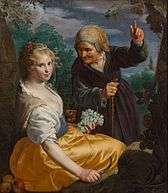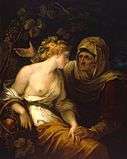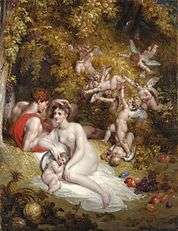The Elm and the Vine

The Elm and the Vine were associated particularly by Latin authors. Because pruned elm trees acted as vine supports, this was taken as a symbol of marriage[1] and imagery connected with their pairing also became common in Renaissance literature. Various fables were created out of their association in both Classical and later times. Although Aesop was not credited with these formerly, later fables hint at his authorship.
Marriage imagery
The 'marriage' of elm trees and vines continued in Italy from Roman times into the 20th century.[2] There are references to this in both works on husbandry and in poetry. The most famous of the latter was Ovid's account of the myth of Vertumnus and Pomona in his Metamorphoses. Vertumnus takes the shape of an old woman and urges the reluctant goddess to marriage by pointing to the vine in her orchard. In the version by the work's first English translator, Arthur Golding:
- Ageinst him where he sat
- A goodly Elme with glistring grapes did growe: which after hee
- Had praysed, and the vyne likewyse that ran uppon the tree:
- But if (quoth hee) this Elme without the vyne did single stand,
- It should have nothing (saving leaves) to bee desyred: and
- Ageine if that the vyne which ronnes uppon the Elme had nat
- The tree to leane unto, it should uppon the ground ly flat.
- Yit art not thou admonisht by example of this tree
- To take a husband, neyther doost thou passe to maryed bee.[3]
The subject was commonly painted in Europe between the 16th - 18th centuries, and there are examples which feature a vine trained up an elm from Italy, the Netherlands, France and England (see the Gallery below). This was partly encouraged by the entry of the imagery into Emblem books, beginning with the most popular of them all, Andrea Alciato's Emblemata, in which it figures under the title Amicitia etiam post mortem durans (Friendship lasting even after death).[4] This interpretation had been influenced by a first-century CE poem by Antipater of Thessalonica in which a withered plane tree (rather than an elm) recounts how the vine trained about it keeps it green.[5] Alciato was followed in this interpretation by Geoffrey Whitney in England,[6] using Alciato's illustration but accompanied by verses of his own. Others who took up this theme include Jean Jacques Boissard in his Emblemes latins (1588)[7] and the Dutch poet Daniel Heinsius in his Emblemata Amato ria (1607). The latter makes the tree a plane, following the Greek epigram, interpreting it as the sign of undying love. The French version of his Latin poem reads
- Comme à la plane on voit la vigne survivante,
- Mon amour survivera à l’injure du sort
(As the vine survives about the plane, So will my love the stroke of fate).[8]
Grateful dependence of a different sort was signified by the French emblem of Gilles Corrozet in his Hecatomographie (1540), where a fruiting vine acknowledges its debt to the 'little tree' that supports it.[9] In the following century an adaptation of the emblem was adopted as printer's mark by the House of Elzevir for their press in Leiden. There a scholar picks grapes from the vine trained round the tree, on the other side of which is the Latin device Non Solus (not alone), pointing to the alliance between learning and literature.[10]
Vertumnus and Pomona from the 16th – 19th century
-

Francesco Melzi 1517-20
-

Hendrik Goltzius 1613
-

Abraham Bloemaert 1620
-

Paulus Moreelse 1630
-

A tapestry design by François Boucher, 1757
-

William Hamilton, 1789
-

Richard Westall, early 19th century
The fables
A fable, or at least a parable, of the mutual support of the unfruitful elm and the fruiting vine appeared early on in the quasi-Biblical Shepherd of Hermas. The interpretation given it there was that the rich are in need of the prayers of the poor, which they can only acquire by acts of charity.[11] There is a return to the association with marriage in the anonymous poem "The Elm and Vine", first published in England in 1763 and reprinted elsewhere for some fifty years both there and in the USA. The story is set "In Aesop's days, when trees could speak" and concerns a vine that scorns the tree's proposal, only to take it up when beaten down by a storm.[12] Much the same story was versified in the 19th century by the Mexican fabulist Jose Rosas Moreno, then in turn translated in a condensed version by the American poet William Cullen Bryant.[13]
A different fable appeared in prose in Robert Dodsley's Select Fables of Esop (1764). This, however, was an adaptation of the fable of The Gourd and the Palm-tree and appeared in the book's third section of 'modern fables'.[14] There the pert vine refused the elm's proposal and boasted of being able to rely on its own resources. The elm replies to the 'poor infatuated shrub' that misapplication of its resources will soon bring about its downfall. The text was reissued in a 1776 edition of Dodsley's work illustrated by Thomas Bewick and again in John Brocket's Select Fables (Newcastle 1820), also with Bewick's woodcut.[15]
References
- ↑ Peter Demetz, “The elm and the vine: notes towards the history of a marriage topos”, Proceedings of the Modern Language Association, 73.5, New York 1958, pp. 521-532
- ↑ The historical relationship of elms and vines, P. Fuentes-Utrilla, R. A. López-Rodríguez and L. Gil, Universidad Politécnica de Madrid 2004.
- ↑ Book 14, lines 755-63
- ↑ Emblem 160
- ↑ Greek Anthology III.231
- ↑ Choice of Emblemes 62
- ↑ pp 64-5
- ↑ Alison Saunder, The seventeenth-century French emblem: a study in diversity, Geneva CH 2000 p.168
- ↑ Glasgow University Library
- ↑ The Private Library
- ↑ III.2
- ↑ The Gentleman's Magazine 33, p.510
- ↑ Story telling poems, ed. Frances Jenkins Olcott, New York and Boston 1913, p.40
- ↑ Fable 31
- ↑ Google Books